Clues to Bird Identification
One of the most enjoyable aspects of attracting birds is identifying which species come to your backyard. For the beginner, this can seem overwhelming, but with help, and a little bit of time, it’s doable. We’re firmly convinced that anyone can ID the birds in their backyard. And don’t worry about making mistakes – even the experts misidentify a bird at times. So, you can do it, and we’re here to help.
There are many clues to bird identification, but it really boils down to some combination of the following:
- Body shape
- Bill shape
- Color pattern
- Size
- Behavior
- Songs and calls
- Habitat
- Range
You don’t need to memorize all of these keys for identifying every species. In fact, for some, you really only need one or two. For example, a male Northern Cardinal has such a unique color pattern (red body and black in the face and throat) that no other type of bird in North America has the same pattern, and it can easily be identified. For others, though, you may need more of the keys to positively ID them.
With some birds, the first step is to narrow it down to a group, like the wrens, before trying to refine it to the exact species. For example, you start with the mystery bird being a wren, before trying to decide whether it’s a Carolina Wren, Bewick’s Wren, or House Wren.
Let’s go through each of these keys in detail.
Body Shape
Different birds have different body shapes. A hummingbird’s shape is completely different than that of a goose, or a hawk, or a robin. They all have the same body parts, it’s just that some parts are larger or smaller, relative to the rest of the body.
Crest
Birds with crests, like the Northern Cardinal and Tufted Titmouse, have the feathers on the top of the head elongated. When raised, they give the appearance of a crest.
Tail
Much variety exists in tail shape throughout the bird world. Some are short, others long, and others longer still. They can be forked. Or squared off. Or rounded. Or “V” shaped.
In the sketches below, notice the deeply forked tail of the Barn Swallow (far left), the slightly forked tail of the Purple Martin (second from left), the rounded tail of a Swainson's Hawk (third from left), and the V-shaped tail of a Common Raven (far right).
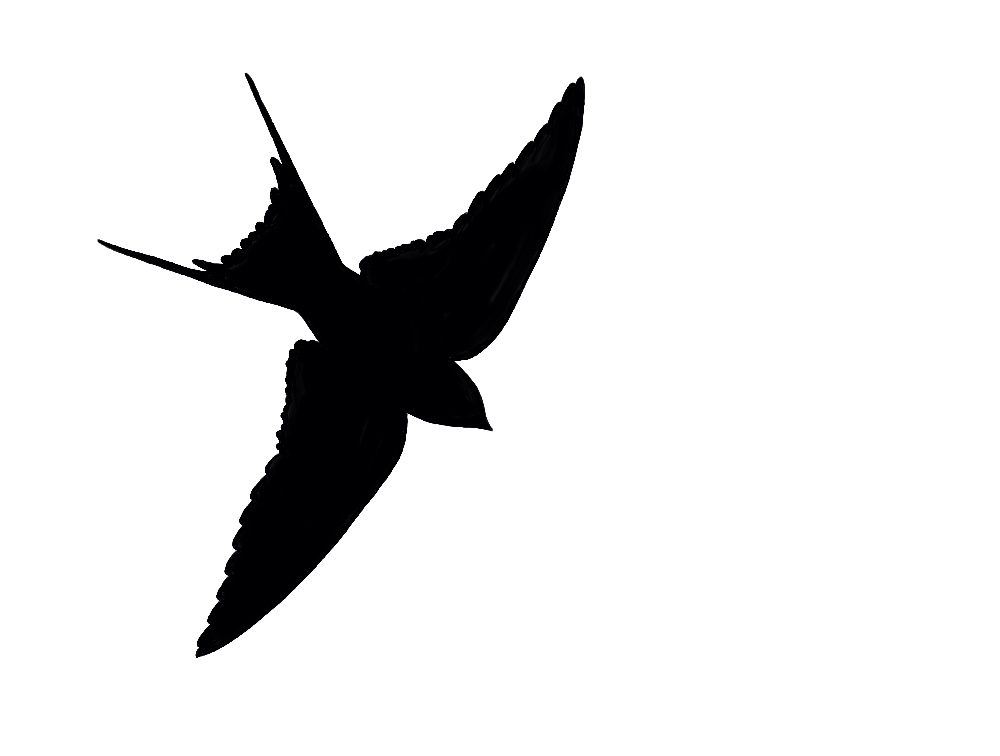 |
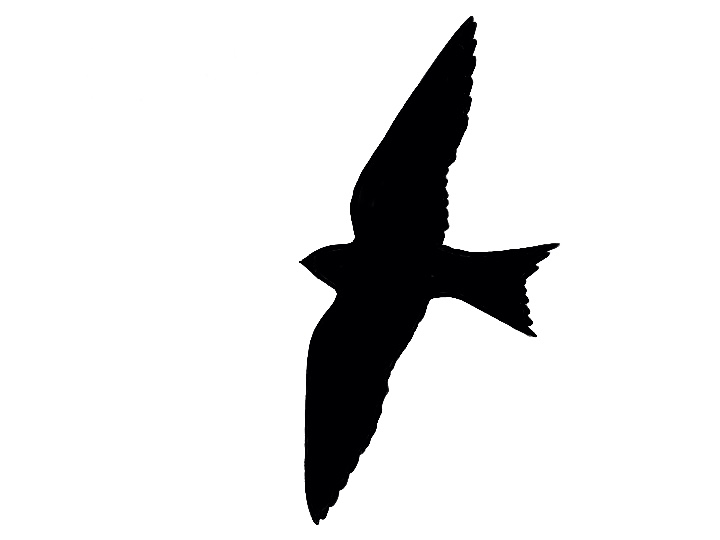 |
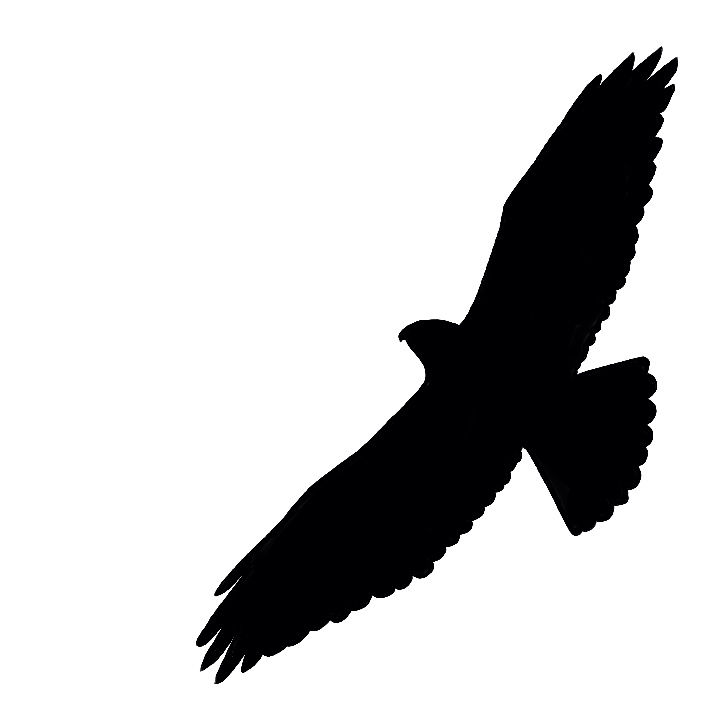 |
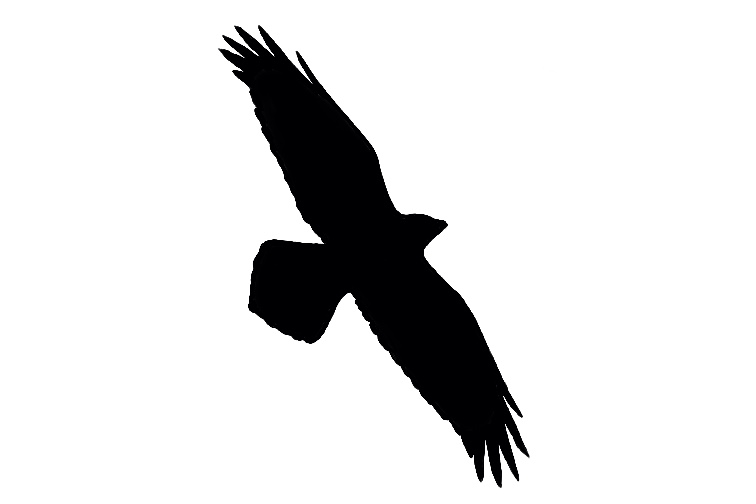 |
Posture
The way a bird holds itself can really help narrow down which group it belongs to. Some birds perch or stand erect, while others tend to lean forward. Some hold the tail down, while others raise it above the body, and still others hold it out more level with the body.
Bill Shape
Bill shape can quickly and easily narrow a bird down to a group. Sometimes, even down to the species. The biggest problem with relying on bill shape is that you need to get a good look at the bird, and sometimes that’s not easy. Some of the characteristics of the bill to look for are length, how stout it is, and does it hook or curve in some way.
Color Pattern
Color pattern is often the first thing you see when looking at a bird. And sometimes it is the only thing you get to see. Since birds are active and mobile, a bird may move before you get the chance to look it over carefully. Here are the most common things to look for (just know that not every bird will have all of these):
- Head pattern
- Stripes on the top of the head
- Color of the lores (space between the eye and bill)
- Presence of a “moustache”
- Color of the throat
- Contrasting color surrounding the eye, and whether it is a partial or complete circle
- Spotting on the breast
- Contrasting color of the breast
- Contrasting color of the belly
- Contrasting color of the wings
- Color bands in the tail
- White outer tail feathers
- Contrasting color on the back just above the tail
- Contrasting color of the feathers just under the tail
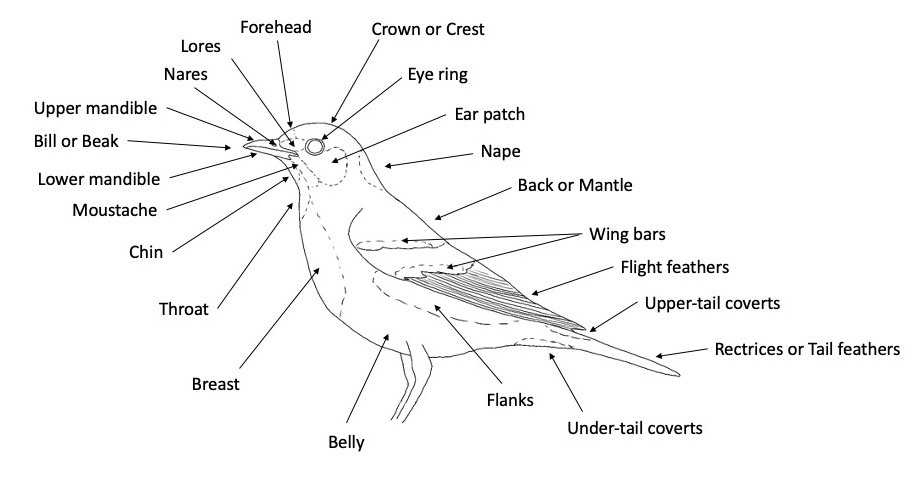 Parts of a bird
Parts of a bird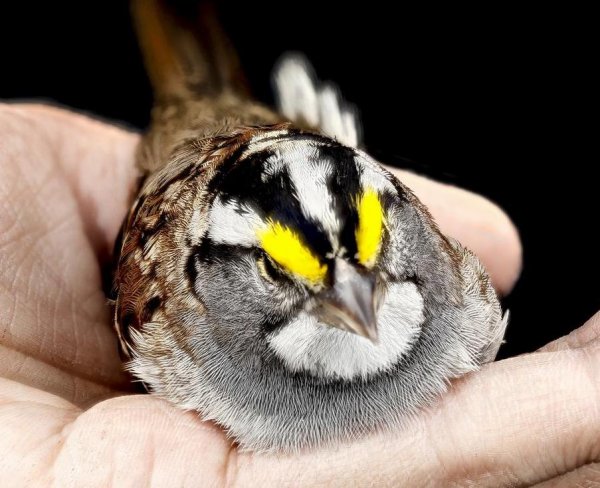 White-throated Sparrow head pattern
White-throated Sparrow head patternSize
Size tends to be one of the least reliable aspects of bird ID, but when used correctly it can be invaluable. The problem with using size is that you really need something to use as a reference. Too often, a bird perched all by itself will look either larger or smaller than it really is. Only when the bird is near an object of known size can you really be sure. Of course, that object of known size can be another bird standing or perched nearby. Then you can use the relative size difference to help identify your mystery bird.
Behavior
Behavior can be diagnostic. Or not. It just depends. More than any of the other keys to bird ID, behavior is the one that takes the most time to learn. It’s not as simple as comparing pictures from a book. It takes time observing birds and remembering what you see. Here are some of the categories of behavior to look for when you watch birds.
Foraging
How does the bird feed? The most common ways birds forage that can be helpful include
- Picking small insects off leaves and bark of trees or shrubs (called gleaning)
- Flying out to catch insects in flight (called sallying)
- Scratching at dead leaves for insects
- Walking or hopping across the lawn in search of insects or worms
- Hovering at flowers to drink nectar
Perching
Where and how does the bird perch? Is it on a tree trunk (as opposed to the most common way of perching on horizontal limbs), and if so, does it perch with its head pointing up or down?
Flight
How does the bird fly? Things to look for in flight include
- Soaring
- Gliding - some birds never glide when flying
- Speed of wingbeats - some birds flap rapidly (to the point of not being able to see the wings as anything but a blur), while others are slower and more deliberate
- Deepness of wingbeats - are the wingbeats shallow or deep
- Undulating flight - some birds, particularly woodpeckers use a “flap, flap, glide…flap, flap, glide…” pattern that looks a bit up-and-down
Other Behaviors
There are some other behaviors that can be helpful, but don’t fit easily into the above categories.
- Hop vs. Walk - does the bird hop across the lawn or walk?
- Tail flicking - when perched, does the bird flick its tail up and down repeatedly or sit still?
- Head bobbing
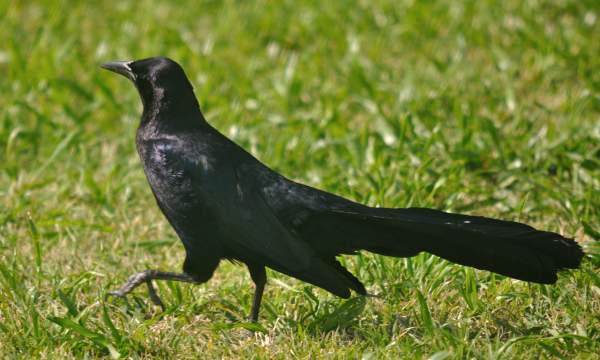 Great-tailed Grackle walking across the lawn
Great-tailed Grackle walking across the lawnThere are a number of bird behaviors that are quite entertaining and interesting, but don’t really contribute to helping ID them. Observing these can really enrich your backyard bird experience. A few of these include
Courtship displays
In many species, males have a courtship display they use to attract a female. These can take a wide variety of forms, from flight displays of hummingbirds, to showing the red wing patches of Red-winged Blackbirds, to elaborate displays or wings and tails, like in Great-tailed Grackles. Generally, these displays are accompanied by songs or calls that add a whole other element to enjoy.
Courtship feeding
Males often bring food to their mates, either before they begin to nest, or while the females are incubating eggs. Courtship feeding is often accompanied by a wing-fluttering display given by the females. Courtship feeding is not always easy to observe, but when you do, it can be really fascinating.
Behavior of young
When young are out of the nest, but not independent of their parents, there are a number of behaviors that can keep you entertained. Young birds are not experienced at flight when they leave the nest, and watching them learn is fascinating, and sometimes quite funny. The young of many species are not capable of foraging on their own and rely on their parents for several weeks or more to provide food. They will follow their parents around, begging for food. Begging is accompanied by distinctive calls, as well as wing-fluttering displays. As far as we are concerned, watching young birds that were raised in your backyard can be the most rewarding aspect of attracting birds to your yard.
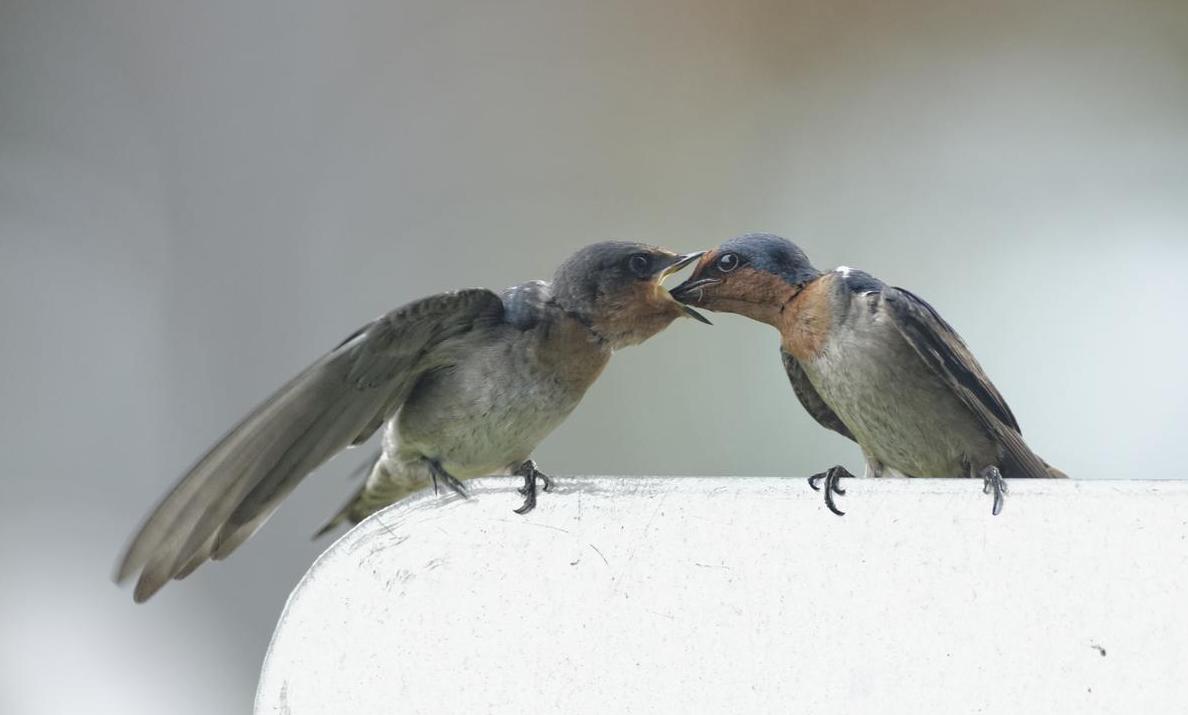 Parent (right) feeding a baby bird
Parent (right) feeding a baby birdSongs and Calls
The songs and calls birds produce can be the surest way to identify a species, since their purpose is to communicate with other members of the species. This means that they are distinctive and generally unique for a species. If you learn a species' songs and calls, you can be sure of your ID. Unfortunately, most species show some amount of variability in both their songs and their calls, and learning them can take a long time. Some species have only one or a few types of songs, but others have large and complex repertoires of songs. In those cases, it’s probably not possible to learn all the songs in a large repertoire, but you can learn the general patterns and tone of the songs, and this can lead you to help identify the species.
Calls tend to be the shorter, and generally less musical, notes that birds produce. Sometimes these are unique to a species and can be diagnostic. Others tend to sound similar to the calls of other species. The key to differentiating them is the tone and pitch of the notes. For example, a number of species give a “chip” note at times, and they can sound very similar, but careful study of them will reveal differences.
How do you learn a species' songs and calls? There are two main aspects to this. The most important part is listening. And remembering. The second is finding reference material to compare against. Most good field guides have a short description of the songs of a species, and sometimes a call if it is distinctive. The best way, though, is through the internet. Multiple websites have audio recordings you can listen to or download. Since there can be much variability within a species, you might have to listen to multiple recordings to get a good feel for a species.
Habitat
Different birds feel comfortable in different types of vegetation. Some like the intimacy or safety of heavy foliage, while others are always found in more open settings. Some species live most of their life on or near the ground, while others are strictly arboreal and live only in trees. Some need marshes and wetlands, while others are found only in deserts or arid areas. Some seem to prefer living around humans, while others are rarely, if ever, found in close proximity to humans. And some require water for swimming and diving. Knowledge of a species’ needs can be very helpful when identifying birds.
Range
Range can be very helpful in narrowing down an identification, but it can also mislead you at times. The problem is that birds are mobile. Highly mobile. And because of that, they can occasionally be found way outside their normal range. A storm, particularly during migration, can blow a bird hundreds of miles away from their normal range.
Range maps should only be used as a guide. They are based on the probability of seeing a bird. For areas outside the range on a map, you are unlikely to see the species, but it is still possible. Conversely, for areas within the range on a map, the chances of seeing a bird are much better, provided you are in the appropriate habitat for that species.
Final Thoughts
In summary, there are a wide range of clues you can use to help identify a bird in your backyard. From shape and size, to color, behavior, vocalizations, habitat, and range. Just remember, you don’t have to learn it all at once. Watch. Observe. Read. And it will come to you. And make bringing birds to your backyard a very rewarding experience. Enjoy!